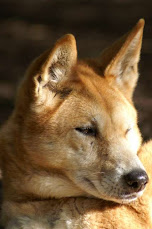
(uncia uncia)
Location: Mountains of Central Asia, specifically the Himalayas, Altai and Hindu Kush
Habitat: They show a strong preference for a habitat with broken terrain, rocky outcrops and ravines as opposed to open smooth slopes and densely forested areas
Due to their excellent camoflauge, elusive behavior and small numbers snow leopards are rarely seen in the wild and are difficult to study. Much of the information we have has been from research on captive animals.
This medium sized cat is very well adapted to living in the cold, mountainous regions. Their fur is long, thick and a smokey-gray color with dark gray to black rosettes and spots. They have a lighter fur coat in the winter. Their body is about 4-5 feet long, with a 3 foot long tail. This tail is coverd with long fur and is wrapped around the body while resting for warmth and it helps with their balance. They have short forelimbs and long hind limbs that increase their agility in the rough terrain. They have large paws with fur on the bottoms which help them walk in the snow. They have a well developed chest and enlarged nasal cavities which help them in the cold thin air of their high altitude habitat.
This animal is crepuscular, active during dusk and dawn. However, they may be active throughout the day where there are few people and they may become nocturnal in areas where there are more people. They are solitary animals with territores that will overlap slightly and they will come together only during the mating season. However, male and female pairs have shown high sociability and bonding in zoos. They do not roar but they do make other vocalizations such as moans, yowls and “prustens” which are similar to grunts.
A snow leopard is able to kill prey three times its weight. Their most common prey are blue sheep, or bharal, of Himalaya and Tibet and Asiatic ibex, a wild goat found throughout the major mountain ranges of Central Asia. They also will feed on smaller prey including wild boar, tahr, gazelles, marmot, pika, hares and other small rodents as well as game birds. When faced with little natural prey they will feed on livestock such as horses, sheep, goats and young yaks. They will stalk their prey and spring from a distance of 20 to 50 feet for a kill. They have loose belly skin which allows them to be kicked by prey with very little damage. They eat very slowly and will stay with the kill to protect it from scavengers such as vultures or ravens. Therefore, they only need to hunt for food about twice a month.
It has been estimated that there are about 3,500 to 7,000 left in the wild. There are about 600 – 700 in zoos around the world. There are many threats to this animal. Poaching is a major problem. Their fur is highly prized in the fur trade and their body parts are used in traditional Asian medicine. They are competing for their prey with humans who hunt goats and sheep for trophies. When they are forced to hunt livestock, natives will kill the leopards in retaliation. Another major one is loss of habitat which occurs when humans overtake their habitat. Because of the lack of awareness by the native people they are reluctant to participate in conservation efforts. The law enforcement of protected parks is severely lacking.
The snow leopard has been categorized as an endangered species by the World Conservation Union (IUCN) since 1972 and is protected by the Convention on International Trade in Endangered Species of Wild Fauna and Flora (CITES Appendix I), which makes trafficking live cats, fur or body parts illegal.



